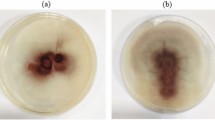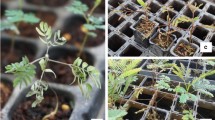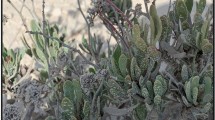Abstract
Previously, we showed that the sugar transporter MfsX in the major facilitator superfamily is involved in the pathogenicity of Dickeya dadantii (syn. Erwinia chrysanthemi). Here, we show that a mutation in this gene resulted in increased susceptibility to several antimicrobial agents, reduced biosynthesis of a blue pigment indigoidine, and reduced chemotaxis towards some sugars and amino acids and in pellicle formation. These phenotypes in D. dadantii have been thought to be important for survival in planta. Thus, this MfsX sugar transporter may contribute to pathogenicity by enhancing in planta survival of the phytopathogen.





Similar content being viewed by others
References
Barabote RD, Johnson OL, Zetina E, San Fransisco SK, Fralick JA, San Fransisco MJD (2003) Erwinia chrysanthemi tolC is involved in resistance to antimicrobial plant chemicals and is essential for phytopathogenesis. J Bacteriol 185:5772–5778
Barnard AML, Salmond GPC (2006) Quorum sensing in Erwinia species. Anal Bioanal Chem DOI 10.1007/s00216-0701-1
Bauer DW, Bogdanove AJ, Beer SV, Collmer A (1994) Erwinia chrysanthemi hrp genes and their involvement in soft rot pathogenesis and elicitation of the hypersensitive response. Mol Plant Microbe Interact 7:573–581
Borges-Walmsley MI, Walmsley AR (2001) The structure and function of drug pumps. Trends Microbiol 9:71–79
Cangelosi GA, Ankenbauer RG, Nester EW (1990) Sugars induce the Agrobacterium virulence genes through a periplasmic binding protein and a transmembrane signal protein. Proc Natl Acad Sci USA 87:6708–6712
Chan YY, Chu KL (2005) The Burkholderia pseudomallei BpeAB-OprB efflux pump: expression and impact on quorum sensing and virulence. J Bacteriol 187:4707–4719
Chatterjee A, Cui Y, Liu Y, Dumenyo CK, Chatterjee AK (1995) Inactivation of rsmA leads to overproduction of extracellular pectinases, cellulases, and proteases in Erwinia carotovora subsp. carotovora in the absence of the starvation/cell density sensing signal, N-(3-oxohexanoyl)-l-homoserine lactone. Appl Environ Microbiol 61:1959–1967
Clarke S, Koshland DE Jr. (1979) Membrane receptors for aspartate and serine in bacterial chemotaxis. J Biol Chem 254:9695–9702
Collmer A, Keen NT (1986) The role of pectic enzymes in plant pathogenesis. Annu Rev Phytopathol 24:383–453
Condemine G, Castillo A, Passeri F, Ennard C (1999) The PecT repressor coregulates synthesis of exopolysaccharides and virulence factors in Erwinia chrysanthemi. Mol Plant Microbe Interact 12:45–52
Cuppels DA (1988) Chemotaxis by Pseudomonas syringae pv. tomato. Appl Environ Microbiol 54:629–632
El Hassouni ME, Chambost JP, Expert D, Van Gijsegem F, Barras F (1999) The minimal gene set member msrA, encoding peptide methionine sulfoxide reductase, is a virulence determinant of the plant pathogen Erwinia chrysanthemi. Proc Natl Acad Sci USA 96:887–892
Enard C, Diolez A, Expert D (1988) Systemic virulence of Erwinia chrysanthemi 3937 requires a functional iron assimilation system. J Bacteriol 170:2419–2426
Franklund CV, Baron SF, Hylemon PB (1993) Characterization of the baiH gene encoding a bile acid-inducible NADH:flavin oxireductase from Eubacterium sp. strain VPI 12708. J Bacteriol 175:3002–3012
Feng X, Baumgartner JW, Hazalbauer GL (1997) High- and low-abundance chemoreceptors in Escherichia coli: differential activities associated with closely related cytoplasmic domains. J Bacteriol 179:6714–6720
Hancock RE, Diamond G (2000) The role of cationic antimicrobial peptides in innate host defenses. Trends Microbiol 8:402–410
Hugouvieux-Cotte-Pattat N, Blot N, Reverchon S (2001) Identification of TogMNAB, an ABC transporter which mediates the uptake of pectic oligomers in Erwinia chrysanthemi 3937. Mol Microbiol 41:1113–1123
Joko T, Hirata H, Tsuyumu S (2007) Sugar transporter (MfsX) of the major facilitator superfamily is required for flagella-mediated pathogenesis in Dickeya dadantii 3937 (in press)
Kohler T, van Delden L, Curty K, Hamzehpour MM, Pechere JC (2001) Overexpression of the MexEF-OprN multidrug efflux system affects cell-to-cell signaling in Pseudomonas aeruginosa. J Bacteriol 183:5213–5222
Lamb C, Dixon RA (1997) The oxidative burst in plant disease resistance. Annu Rev Plant Physiol Plant Mol Biol 48:251–275
Llama-Palacios A, Lopez-Solanilla E, Poza-Carrion C, Garcia-Omeldo F, Rodriguez-Palanzuela P (2003) The Erwinia chrysanthemi phoP-phoQ operon plays an important role in growth at low pH, virulence and bacterial survival in plant tissue. Mol Microbiol 49:347–357
Loake GJ, Ashby AM, Shaw CM (1988) Attraction of Agrobacterium tumefaciens C58C1 towards sugars involves a highly sensitive chemotaxis system. J Gen Microbiol 134:1427–1432
Lopez-Solanilla E, Garcia-Olmedo F, Rodriguez-Palenzuela P (1998) Inactivation of the sapA to sapF locus of Erwinia chrysanthemi reveals common features in plant and bacterial pathogenesis. Plant Cell 10:917–924
Marger M, Saier MH Jr. (1993) A major superfamily of transmembrane facilitators that can catalyze uniport, symport and antiport. Trends Biochem Sci 18:13–20
Nikaido H (1996) Multidrug efflux pumps of gram-negative bacteria. J Bacteriol 178:5853–5859
Pao SS, Paulsen IT, Saier Jr MH (1998) Major facilitator superfamily. Microbiol Mol Biol Rev 62:1–34
Pérombelon MCM, Kelman A (1980) Ecology of the soft rot erwinias. Annu Rev Phytopathol 18:361–387
Putman M, van Veen HWV, Konings WN (2000) Molecular properties of bacterial multidrug transporters. Microbiol Mol Biol Rev 64:672–693
Raymundo AK, Ries SM (1980) Chemotaxis of Erwinia amylovora. Phytopathology 70:1066–1069
Reverchon S, Rouanet C, Expert D, Nasser W (2002) Characterization of indigoidine biosynthetic genes in Erwinia chrysanthemi and role of this blue pigment in pathogenicity. J Bacteriol 184:654–665
Samson R, Legendre JB, Christen R, Saux MF-L, Achouak W, Gardan L (2005) Transfer of Pectobacterium chrysanthemi (Burkholder et al. 1953) Brenner et al. 1973 and Brenneria paradisiaca to the genus Dickeya gen. nov. as Dickeya chrysanthemi comb. nov. and Dickeya paradisiaca comb. nov. and delineation of four novel species, Dickeya dadantii sp. nov., Dickeya dianthicola sp. nov., Dickeya dieffenbachiae sp. nov., and Dickeya zeae sp. nov. Int J Syst Evol Microbiol 55:1415–1427
Schoonejans E, Expert D, Toussaint A (1987) Characterization and virulence properties of Erwinia chrysanthemi lipopolisaccharide-defective, phiEC2-resistant mutant. J Bacteriol 169:4011–4017
Sourjik V (2004) Receptor clustering and signal processing in E. coli chemotaxis. Trends Microbiol 12:569–576
Yang S, Lopez CR, Zechiedrich EL (2006) Quorum sensing and multidrug transporters in Escherichia coli. Proc Natl Acad Sci USA 103:2386–2391
Yao J, Allen C (2006) Chemotaxis is required for virulence and competitive fitness of the bacterial wilt pathogen Ralstonia solanacearum. J Bacteriol 188:3697–3708
Yap MN, Yang CH, Barak JD, Jahn CE, Charkowski AO (2005) The Erwinia chrysanthemi type III secretion system is required for multicellular behavior. J Bacteriol 187:639–648
Acknowledgments
We are grateful to The Hitachi Scholarship Foundation (Japan) for the graduate support of T.J. This work was supported in part by a grant-in-aid (no. 12052210) and by a grant for promotion of science (no. 13073) from the Ministry of Education, Culture, Sports, Science, and Technology in Japan.
Author information
Authors and Affiliations
Corresponding author
Rights and permissions
About this article
Cite this article
Joko, T., Hirata, H. & Tsuyumu, S. A sugar transporter (MfsX) is also required by Dickeya dadantii 3937 for in planta fitness . J Gen Plant Pathol 73, 274–280 (2007). https://doi.org/10.1007/s10327-007-0019-7
Received:
Accepted:
Published:
Issue Date:
DOI: https://doi.org/10.1007/s10327-007-0019-7




